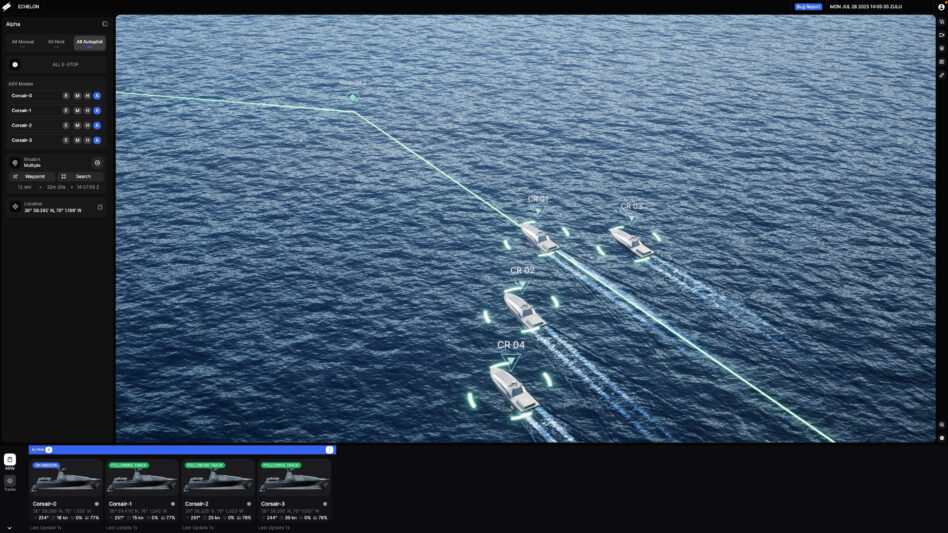Another heavyweight is jumping into the command and control (C2) ring. This morning, unmanned surface vessel (USV) maker Saronic Technologies unveiled Echelon, a C2 system built for the unique demands of the maritime domain.
Saronic CTO Vibhav Altekar described it to Tectonic as a unified portal to manage everything that could impact an autonomous fleet.
“In the maritime domain, there [are] a lot of components that are fundamentally differentiated from what we’ve seen in the past in terms of other autonomous systems,” Altekar said. “[Echelon is] a maritime-specific command and control interface, simulation platform, mission platform, as well as a good way of understanding the status and reliability of the fleet.”
Autonomy at sea: Before we dive into Echelon, a little context on Saronic. The company was founded in 2022, born out of 8VC’s Build program. Since then, they’ve picked up some pretty serious cash. The company:
- Closed a $600M Series C at a $4B valuation back in February.
- Is backed by heavy-hitting investors, including General Catalyst, 8VC, a16z, Caffeinated Capital, and Lightspeed.
- Says it’s building a futuristic shipyard called Port Alpha, and snapped up Louisiana-based shipbuilder Gulf Craft back in April.
- Also teamed up with marine fabrication and maintenance giant Vigor Marine Group earlier this month.
Saronic has announced a range of six autonomous vessels, from the six-foot Spyglass up to the 150-foot Marauder. They’ve leaned particularly hard into medium and large USVs in recent months. (We see you, BBB funding.)
Altekar said that the C2 system was designed hand-in-hand with all of these boats. “Echelon has been what we’ve been using since the beginning,” he said, “The more boats we build, the better the system autonomy gets because you have larger volume. You can collect more data.”
Built different: We asked Altekar why Saronic decided to build their own C2 when there are so many systems out there. He told us autonomy at sea is a totally different beast than in the air.
“Echelon gives you…both autonomy aware, but also system-level alerts and observability to help you get a really good understanding of what’s going on in the ocean,” he said, “What’s the sea state? What are the conditions? How is this going to impact your system and make sure that you have reliable and safe operations out in the water?”
Here’s how it all works:
- Echelon collects sensor data from all of the “maritime robots” (i.e., USVs, subsea sensors) plugged into it, and combines it with publicly available information, like weather data.
- It tracks everything from subsea conditions to fleet condition, and folds that into simulation and mission planning pre-operations, and control of autonomous vessels during operations.
- The C2 system was designed to work in comms-degraded and comms-denied environments—most of the ocean is tricky, comms-wise, Altekar pointed out.
- It also works even when autonomous vessels are in super-rough conditions or take on a ton of water. “Salt water is cancer for electronics,” Altekar said.
- It’s designed to run on the less-than-ideal computing platforms available at sea—everything from a ruggedized tablet or laptop up to a command center.
The whole thing, Altekar added, was designed to be as easy as possible for sailors and boat captains. “Our users—especially the folks who are maritime native—are really happy that there’s something that actually cares about like their specific needs or like the specific questions that a sailor would ask.”
Plug it in: Altekar said that Echelon was designed to work with other C2 systems and other companies’ maritime hardware. He said a bunch of government partners and other companies have already tried it.
“We’ve found in feedback from a lot of different people that have integrated with it that it’s been pretty fast and pretty stable in terms of integrations with other C2 systems,” he said, “It’s just an API integration.”
Basically, Echelon adds maritime-specific depth to the wealth of C2 already out there. “You can have a common operating picture that gives you your insights across all of the other domains,” he said, “You can also have something specific for the people that understand their domain.”
When asked whether they would sell Echelon to other companies and government partners, Altekar said the company thought it was a “valuable tool” and a “useful piece of technology” for all the companies entering the maritime autonomy space. However, he said he couldn’t comment on specific users or whether there are any government contracts for Echelon in the works.

